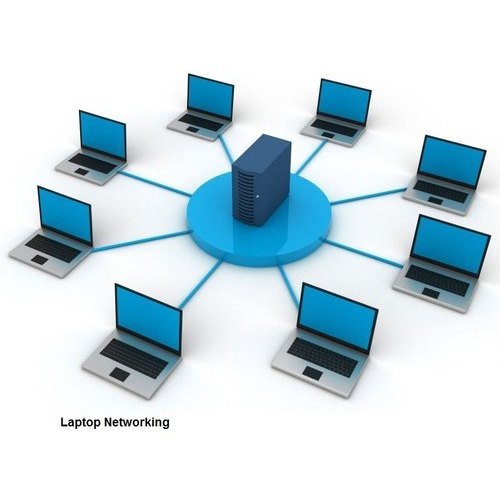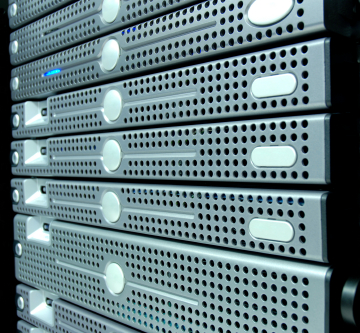Subtotal: 17.00 $
Servers form an important function in the Office workspace, it helps to centralize office information and helps you work more effectively, which helps to secure data’s.
In an office of ten staff each of them have their desk and computers they are working on, the files they are working on should never be installed directly on the computers they are using instead the right way to have your employees access to this files is to install the program on a main Computer that would be serving both the employers and customers through out the office.
All the client data are on the main server Computer, all employers can have access to the files and make changes to them, yet its not directly on their machine but they are actually connected to the server, Server hardware are designed to tolerate more great deal than a normal desktop computer.
What is a Server?
A Server is basically a dedicated poweful Computer that provides services on behalf of clients, such as desktop computer or work station, it a centralized machine where multiply clients connect to either over the internet or in a local area network, they connect to the server for a specific service.
The Servers are not like the normal standard desktop computer most of the servers lack a monitor or a keyboard instead the server comes with a high-powered processor, high-speed RAM and multiple hard drives, as well as a network interface. Server hard drives typically operate at higher speeds than those found in desktops. The combination of high-speed hard drives, RAM and high-powered processors allows a server to offer significantly higher processing power and performance than desktop systems.

Functions of a Server
Server can be used to retrieve a website to access data or email.
A server can be dedicated to handle one of this services only, Large companies often maintain individual servers dedicated to one task, such as email. Servers provide a secure and centralized method of data storage.
While smaller organization set up a server to handle each of the services on the same machine.
How to chose a Server for your Business
Choosing a Server for a business depends on the number of employees and the traffic the business gets.
When you want to purchase a machine that is supposed to be running 24 hours a day and 365 days a year the server and you are not suppose to be shutting it down cannot survive, you cant use a normal consumer grade machine, because the hardware inside those machines is not meant to be run for that length in time and can not tolerate that level of use especially if you have a website stored on your server, the machine is going to crash and no one woukld be able to acesss it, so server grade hardware
Types of servers for businesses
There are many different types of server and organizations will often use a separate server for each purpose. Most commonly, SMBs use servers for:
- Secure email hosting
- Website hosting
- Document storage
- Ecommerce hosting
- Hosting line-of-business applications
- Data backup and recovery.
Proxy servers are worth considering for businesses of any size. By routing web traffic and access through a proxy, your network’s IP addresses are protected from public view (the proxy IP address is shown instead). This anonymity offers your business an additional layer of security.
Hardware or the cloud – choosing the right server for SMBs
A crucial decision you will need to make is whether to have a physical server on-premises or opt for a cloud-based solution. There are pros and cons to each approach and what you decide ultimately comes down to the individual needs of your business.
Cloud servers
Cloud-based servers are well-suited to SMBs with limited space and IT resources. While not as fast or efficient as a dedicated server, businesses will likely find that a cloud-based server is ‘fast enough’ and the lower upfront costs make them an attractive option. Cloud hosting also benefits from redundant power supply and network connections, meaning that if there is a power outage or server issue, your network won’t experience any downtime.
On-premise servers
On the other hand, opting to build or buy a physical server comes with a higher upfront cost. But not paying recurring monthly fees may mean that it works out cheaper in the long run, especially as your business grows. You will also have greater control over how it is set up and integrated with your business cybersecurity solution. The downside is that you are responsible for the cost of replacement hardware and increased electricity for running and cooling the server 24/7.
Protecting your business servers
When utilizing a server within your operations, it is important to ensure it’s protected. Endpoint security is crucial when trying to keep your network safe from viruses, malware, or data breaches. Your server will hold confidential information about your business and its operations, but will also store your employees’ personal data. There are several steps you can take to keep your data secure: provide cybersecurity training for any necessary members of staff, use a server antivirus, track user activity, keep your server up-to-date.
Servers for businesses with Windows
Servers run specialized operating systems that are designed to be robust and able to support many users. The operating system you choose for your server is another important decision. If your business runs on the Microsoft ecosystem, you may already be familiar with Windows server offerings.
In particular, Windows Server Essentials (formerly Windows Small Business Server) is widely used in SMBs with fewer than 25 users. Windows server operating systems are often popular with existing Windows users as they share much of the same code and look very similar to their non-server counterparts.
However, even if you are already running Windows on your PCs, you still have a choice of server operating systems. Other popular options for SMBs:
- Linux Ubuntu Server
- Red Hat Enterprise Linux
- CentOS.
Choosing your operating system
If you have not yet chosen an operating system, consider the following factors:
- Cost. Linux is open-source software and, as such, is often cheaper to run than Windows.
- User-friendliness. Think about how easy the operating system is to install and run, especially if you don’t have dedicated IT staff. Windows is a popular choice for this reason as its interface is often familiar. Linux, on the other hand, presents a steeper learning curve.
- Flexibility. Linux typically offers more flexibility and customization options than Windows, but bear in mind that you will need technical expertise to benefit from this.
- Support. Microsoft is well-known for its high-quality customer support. As Linux is open-source, you may have to hunt around for support.
Setting up a server for an SMB
Whether you build or buy your server, unless you have a dedicated IT team, you’ll need to know how everything fits together. In this section, we’ll walk you through how to build a business server, get it all set up, and how to build the ideal server room.
Building a business server
Servers typically come in three different forms – rackmount, tower, and blade. A tower server looks similar to a home PC but contains server components that are more robust than a consumer computer, allowing them to run 24/7 without interruption. Rackmount and blade servers are installed onto a chassis making them highly expandable and good options for saving space, though both are more expensive than tower systems.
Every server contains specific hardware that determines its resource capacity, in particular, CPU (central processing unit) size, hard disk storage, and RAM (random access memory). You may also wish to incorporate backup hardware components such as hot-swappable drive bays and a redundant power supply, as well as ECC (error correcting code) firmware that detects and corrects errors on the fly to reduce downtime.
The exact specifications of your server will depend on what you need it to do. For example, looking at some common uses:
- A server providing database services would prioritize disk space and a hard drive capable of fast write speeds, as well as support for RAID to provide reliability. (RAID, or redundant array of independent disks, means data is held redundantly in multiple disk drives so that if one fails it is preserved.)
- A file or email server would benefit from multiple hot-swappable drive bays but the CPU is not too important.
- A web hosting server (which works together with a database server) would have higher RAM requirements and would benefit from hardware redundancy.
How to set up a server for a business
While the exact process of setting up a server for an SMB will vary based on your chosen hardware and operating system, there are some common steps you will need to follow.
- Prepare. Before you begin, document your network. Record the names of users, IP address, hostname of each computer, serial numbers, and locations. Check both the hardware specifications and software requirements of your server. You may find that you need to upgrade the operating systems of computers on the network in order to connect them to the server. You will also need to gather any items you need for the installation such as an ethernet cable and external hard drive.
- Install your server. If your server came with an operating system preinstalled, you can connect it to the network and begin configuration. If not, insert the installation media (DVD, USB, virtual media) and follow the instructions to set up your particular operating system.
- Configure your server. As soon as possible after installation, set the server backup (you may need an external hard drive), set up remote access to the server, and set sharing options. Set the server as a domain controller to allow all computers in the network to join the new centralized environment and to allow the server to authenticate user credentials.
- Complete the setup. Add a local admin account to each PC or Mac and connect them to the server. Set up printers and connect them to the print server. Organize and upload the data and applications you wish to have on the new server, for example, your accounting software.
Building a server room
Depending on how much space you have and your hardware choices, setting up a dedicated room to house your server is a worthwhile investment. Besides isolating noisy servers away from employees, you can ensure that everything is properly organized and set up to function optimally. When building your server room, consider the following points:
Room characteristics
Ideally, use a room with no windows and the capacity to install cooling equipment and backup power. Select a space that is big enough that you can reach the front and back of each server rack and, if possible, gives your server space to grow as your business grows.
Invest in the right equipment
While it might be tempting to use a desk or shelf to store your server, the benefits of investing in a rackmount far outweigh the costs. Racks keep your equipment secure, organized, and make it easy to rearrange server units.
You will also need a cooling system to ensure that high temperatures don’t damage your hardware. Consider installing an A/C unit that can be left on continuously, or better still, two units on separate circuit breakers to allow for a redundant supply.
Ensure security
Even for a smaller office server setup, you will need at least a lock and key to protect your expensive equipment and valuable data from theft or tampering. If your budget allows, consider installing a security camera.
A backup power supply is also highly recommended to keep your network and business running without disruption. It is good practice to install an uninterruptible power supply (UPS) to protect against power surges or outages.
Keep it organized
Cable management is an important, but often overlooked, aspect of setting up a business server. Although it requires a little extra work, an RJ45 patch panel can be used to terminate Ethernet cable runs and can provide up to 24 ports. Cable ties are also an effective and inexpensive way to keep cables organized and out of the way.
Lastly, make sure that everything is properly labeled and well-documented. It is also a good idea to document important procedures or instructions relating to your hardware and have this clearly visible near the relevant equipment.
How to set up a business network
If you are investing in a server, it makes sense to consider your whole office network at the same time. This will ensure that it meets your current needs and lays the foundation for your business to expand into the future.
Essentially, a network is a group of interconnected devices, often made up of computers, printers, scanners, and network drives. Creating a network is more efficient as it gives employees centralized access to files and data.
Choosing what’s right for you
There is no one-size-fits-all solution when it comes to setting up a business network. Instead, think about the specific requirements of your business, such as:
- The size of your office
- Number and type of devices your business uses
- What applications your business runs
- What files employees need to share
- How you will protect your network
- Your future expansion plans.
A key consideration when setting up your network is whether to go wired or wireless. While a wireless setup gives you more flexibility in terms of your office layout and design, an Ethernet connection (wired) is generally more reliable, faster, and less expensive. Because of this, some businesses opt to install both a wired and wireless network.
Setting up your network
To create a network, you will need to connect the following components:
- Server. Every network should have at least one server.
- Switches. A switch is a component that connects the devices on your network and allows them to communicate. You will have the choice of managed and unmanaged switches, but SMBs often opt for an unmanaged switch.
- Routers. A router connects different networks together, such as connecting your office network to the internet or creating an intranet.
- Cables. Whether you opt for a wired or wireless network, you will still need cables. The common choices are copper or fiber optic – fiber optic is more durable and provides faster data speeds.
Get business server antivirus protection
Whichever way you decide to set up your network, it will likely contain valuable data and business information so an important consideration is how you will adequately protect it. Cyberthreats evolve every day and SMBs are often an easy target for cybercriminals. A simple way to protect your business is by installing a comprehensive cybersecurity package that includes server antivirus protection. Avast also offers Antivirus for Linux servers, helping you protect your organization no matter what server you use.
How Can a Server Benefit Your Business?

- A Server protects business information by delivering a more reliable and security-enhanced infrastructure. It includes built-in firewall protection and security-enhanced remote access to help prevent unauthorized users from getting into your network.
- A Server helps to ensure network health by keeping your PCs and servers current with the latest updates.
- A Server prevents data loss with automatic data backups and allows you to easily retrieve accidentally deleted files and restore previous versions.
- A Server provides one central place to store business information, meaning you can better manage business-critical information. It’s easier for staff to find, access, and share information and schedules.
- A Server lets you accommodate a mobile work force. Staff can work from virtually anywhere, anytime, with access to e-mail, internal Web sites, network files, and even business applications from any Internet-enabled PC.
- A Server enables staff to share resources and equipment such as Internet access, printers, and fax machines.
- A Server allows you to provide high-speed internet access across a network.
- A Server gives you more processing power. It ‘supercharges’ your network, storing large chunks of data, freeing up memory and enabling individual PCs to perform better.
- A Server allows you to set up new computers, add users and deploy new applications more quickly and easily.
- A Server can help you present a more professional image to your customers. It enables you to run web services, manage web sites, create e-mail newsletters and exploit more sophisticated tools and applications.
- Server software enables you to consolidate your e-mail accounts with suppliers like google mail, Yahoo! and Hotmail into a single, company-hosted e-mail account, enhancing your image to customers and partners.
- A Server can give older PCs a new lease of life – by off-loading their files and data onto a server, older PCs work more quickly and effectively.
ecozeen
I'm a software engineer with a wealth of experience building web solutions for personal brands and organizations.

 Chauffeur Taxi Booking System for WordPress
Chauffeur Taxi Booking System for WordPress 